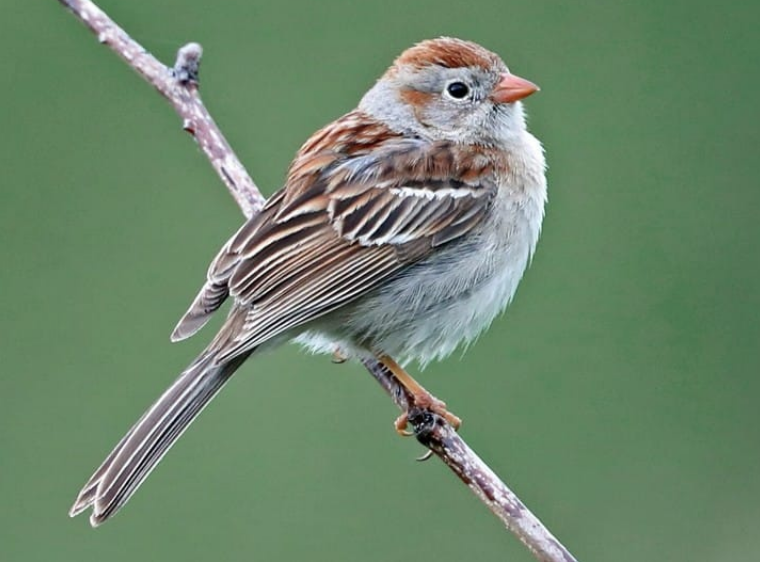Contributed by Bill Hamilton
A great sign of spring is the sound of male Field Sparrows singing their territories and availabilities for mating. Their long, trilling, melodic songs seem to come from the centers of the woody shrubs scattered across open fields. It is often hard to spot the slender, grayish-tan sparrow that generating them. The song is often described as “sad” or “mournful” with a “bouncing ball” ending trill (it accelerates as it goes along like the sound of a dropped ball bouncing over shorter and shorter heights). Field Sparrows are a true “field” species that is quite intolerant of human activity and the structure (and hustle and bustle) of urban and suburban habitats. This fastidiousness of habitat selection has led to declines in the overall numbers of field sparrows, but they are still quite common in most secluded field habitats.
In the winter, both male and female Field Sparrows join multispecies flocks that included a mix of other sparrow species (including Song Sparrows and White Throated Sparrows). Field Sparrows are much less aggressive than these other two types of sparrows and, so, probably spend much of their winter dominated by these more energetic birds. Within these flocks, though, Field Sparrows display great boldness in the face of danger and return to feeding sites (mostly grass seeds) following predator disturbance more rapidly than their flock mates. The increased risk of a lingering or returning predator is offset by a chance of a decent feed!
Male Field Sparrows break away from these winter flocks in early spring and return to their specific breeding sites with great reliability. In these sites, the males begin to sing to mark their territories and interact with each other to establish their breeding boundaries. Females arrive later but tend not to return to the territories of their birth nests or even to the territories in which they might have bred in the previous year. This more random selection of breeding sites by females (coupled with the great specificity of site selection by males) reduces inbreeding within this species.
Arriving females are greeted by the male often with physical contact and superficially aggressive behaviors (the male may fly at a female entering his territory and actually knock her out of the air to the ground). Mate selection, though, quickly follows these altercations, and the female (with little help but often with much attention by the male) builds the nest.
Field Sparrows can have more than one breeding cycle in a spring/summer season, but their nest locations are quite different in the spring vs. the summer. In the spring the nests are usually on the ground amid the growing grasses and weeds. Tree or shrub locations are still not adequately leafed out to provide adequate cover or concealment. Later in the summer, though, the nests are built in the now leafed out trees and shrubs where they are more protected against ground nest predators like snakes.
In the spring and summer Field Sparrows take advantage of a wide range of available foods in addition to their nearly continuous diet of seeds. Insects (including flies, bees, beetles, grasshoppers, and caterpillars) and spiders are protein and energy rich food sources consumed by the adult field sparrows and fed almost exclusively to their nestlings.
A wonderful place to see Field Sparrows is up in the old field “meadows” of Harrison Hills Park. They serenade spring-time walks across the still boot-high vegetation. Watch out, though, for woodchuck holes and remember to check yourself for ticks!
Photo: Cornell Lab of Ornithology
